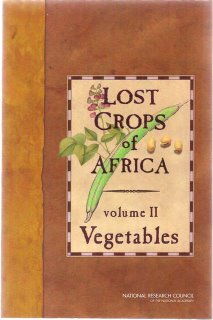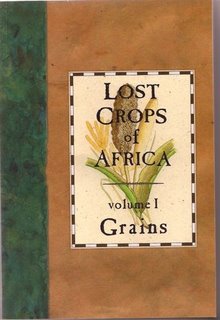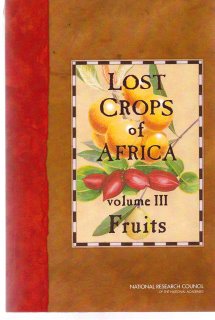"Lost" Crops of Africa

 A comment posted recently by Gnu Guru reminded me that some of you may not be aware of the series currently being compiled by NAP, the National Academies Press, on what they somewhat misleadingly call the "Lost Crops of Africa." [To be fair, in the first volume--and others-- the authors clearly explain that " . . .most of the plants described are not truly lost. . .It is to the mainstream of international science and to people outside the rural regions that they are 'lost.' "] (p. xiii). While the books are quite expensive, they are very useful, and some of the information can be viewed online .
A comment posted recently by Gnu Guru reminded me that some of you may not be aware of the series currently being compiled by NAP, the National Academies Press, on what they somewhat misleadingly call the "Lost Crops of Africa." [To be fair, in the first volume--and others-- the authors clearly explain that " . . .most of the plants described are not truly lost. . .It is to the mainstream of international science and to people outside the rural regions that they are 'lost.' "] (p. xiii). While the books are quite expensive, they are very useful, and some of the information can be viewed online . The "lost crops" series is a planned set of several volumes on traditional, often underutilized and appreciated Sub-Saharan African crops. The first volume, Grains, was published in 1996 and covered a dozen grains from African rice (Oryza glabberima), finger and pearl millets, to fonio, teff, and wild grains. The second, Vegetables, in 2006, featured 18 vegetables, like amaranth, egusi, enset, moringa, okra, and shea. The third volume, Fruits, came out in 2008, and covers a couple dozen fruit resources from baobab and kei apple, tamarind, horned melon and watermelon, to custard apples, sugarplums, ebony, and chocolate berries.
The "lost crops" series is a planned set of several volumes on traditional, often underutilized and appreciated Sub-Saharan African crops. The first volume, Grains, was published in 1996 and covered a dozen grains from African rice (Oryza glabberima), finger and pearl millets, to fonio, teff, and wild grains. The second, Vegetables, in 2006, featured 18 vegetables, like amaranth, egusi, enset, moringa, okra, and shea. The third volume, Fruits, came out in 2008, and covers a couple dozen fruit resources from baobab and kei apple, tamarind, horned melon and watermelon, to custard apples, sugarplums, ebony, and chocolate berries.These books include a wealth of information, and are a cross between scholarly and popular reading. I find them invaluable, and appreciate both the detailed information, illustrations, and the names of experts from around the world. It appears that the series is evolving and changing over time. It was originally anticipated to include 6 volumes: the first on grains, the second on cultivated fruits and the third on wild fruits (they were combined in vol. III), a fourth on vegetables (currently volume II), and a fifth on legumes (these were included in the volume on vegetables), and a final volume on roots and tubers, featuring various yams, tiger nuts (chufa), Hausa and Sudan potatoes, and others.
I'm eager to see the final volume. I've no idea if it's almost completed, but in the first volume readers were encouraged to contact Noel D. Vietmeyer (nvietmey@nas.edu, FAX: 202-334-2660) if they wished to contribute to future volumes (in this case, the volume on roots and tubers), with information about the crop they wished to write about, and the editors especially appealed for photographs.
Labels: african fruits, african grains, african vegetables, lost crops of africa


2 Comments:
If there is a publisher willing to publish these in soft-copy, the price might be lower/cheaper.
I hope someone in some African government makes the copies widely available to us Africans.
Wonderful article.
I was talking to someone in Ghana who lamented how the SourSop (is is native to Ghana?) is ignored yet the climate is great for the tree/plant.
According to vol III of the Lost Crops of Africa "What is not well known is that this famous fruit family (Annonaceae)--[NOTE: aka custard apple] has African members as well. . . [Annona senegalensis]. I've planted one at the house my son is building me in Tema. I'm not very clear on the distinction between the sweet sops and the sour sops, though. The custard apple is a fabulous fruit, and is grown from Senegal to South Africa.
Post a Comment
<< Home